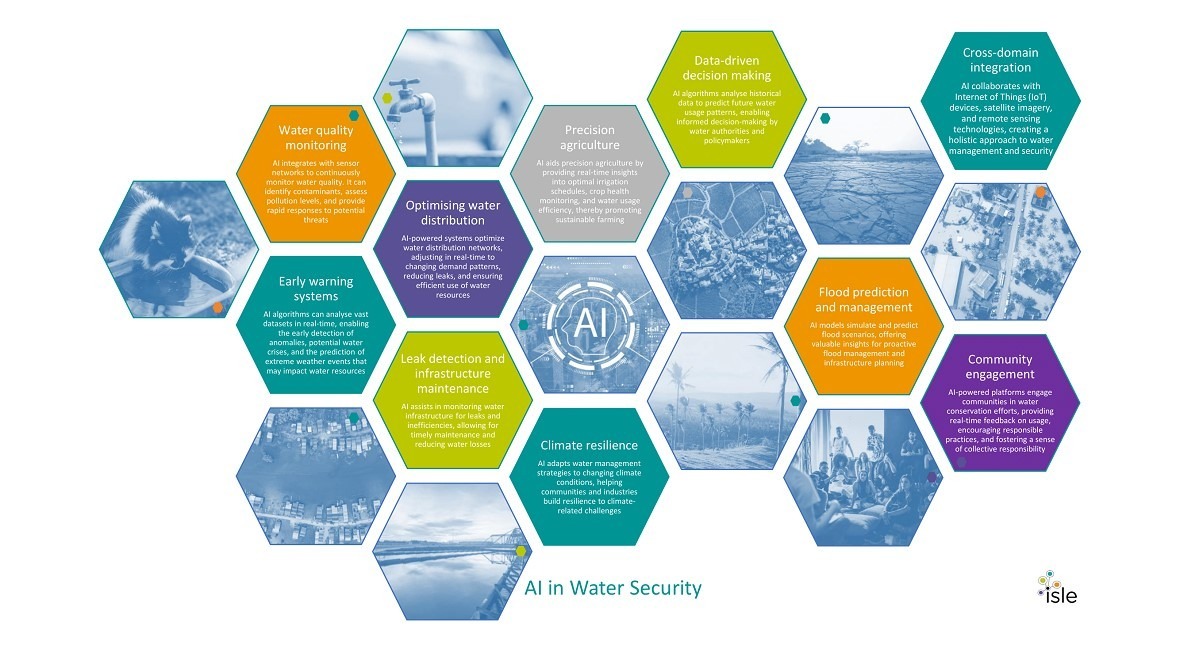Water security: a shared understanding to achieving sustainability through innovation

Explore water security's pivotal role to achieving the sustainable development goals, tackle climate challenges, and embrace innovative solutions, including AI integration.
Water intricately weaves through our economic fabric, sustaining livelihoods across diverse sectors — agriculture, forestry, fishery, energy, industry, recycling, building, and transport. Over three-quarters of jobs hinge on water. As we navigate the complexities of the 21st century, the nexus between water security and sustainable development becomes increasingly evident.
In fact, ensuring water security is vital for advancing Sustainable Development Goals (SDGs) and achieving a more resilient water world. “Clarity on the definition of water security is paramount, addressing confusion amidst related terms like water resilience and water neutrality or even water stewardship”, says Blanca Antizar, Director of Consultancy at Isle Utilities and Visiting Professor in Environmental Security and Resilience at the University College London. Blanca has a special interest in water security and during the last few years has collaborated with Jan Hofman, Professor of Water Science and Engineering and chair of the Water Innovation and Research Centre at the University of Bath on the improved understanding of water security by sectorisation of the urban area and decentralisation of water infrastructure. This collaboration underscores the need for a shared understanding of water security to drive SDGs attainment.
A definition for water security
It therefore becomes imperative to explore various definitions to establish a mutual understanding. Briefly, water resilience is in general understood as the capacity of water systems, communities, or ecosystems to withstand, adapt to, and recover from disturbances, such as extreme weather events, droughts, or other challenges, while maintaining their essential functions. The concept encompasses the ability to bounce back from shocks and stresses and maintain sustainable water management practices. Water neutrality often refers to achieving a balance between water use and water availability, where the amount of water used or consumed is offset by measures that contribute to water conservation or restoration. This concept of water neutrality aims to ensure that water-related activities have a minimal impact on the overall water resources. Besides, the most widely accepted definition of water stewardship is provided by the Water Stewardship Initiative, a collaborative effort involving various organizations: “Water stewardship is the use of water that is socially equitable, environmentally sustainable, and economically beneficial, achieved through a stakeholder-inclusive process that involves site and catchment-based actions”. This definition emphasizes the importance of social equity, environmental sustainability, and economic benefit in the use of water. It also underscores the collaborative and stakeholder-inclusive nature of water stewardship, highlighting the need for actions at both specific sites and catchment levels.
Water security is essential for advancing the Sustainable Development Goals (SDGs) and achieving a more resilient water world
In a broad sense, water security generally refers to the reliable availability of an acceptable quantity and quality of water for health, livelihoods, ecosystems, and production, coupled with an acceptable level of water-related risks. It involves ensuring access to clean water for various uses, managing water resources sustainably, and addressing challenges such as water scarcity, pollution, and climate-related impacts. The United Nations defines water security as “the capacity of a population to safeguard sustainable access to adequate quantities of acceptable quality water for sustaining livelihoods, human well-being, and socio-economic development, for ensuring protection against waterborne pollution and water-related disasters, and for preserving ecosystems in a climate of peace and political stability”. This is the definition suggested to be adopted by the Water Europe Water Security working group lead by Jan Hofman and Blanca Antizar. Water security is essential for advancing the Sustainable Development Goals (SDGs) and achieving a more resilient water world
Unveiling the global impact of water security
In the realm of water operations, the surge of urbanisation and rapid population growth across continents intensify challenges to water security. Demand for water, be it for supply, agriculture, or industry, is set to intensify. A quarter of the global population faces extreme water stress, with over 80% of resources drained for agriculture, industries, and municipalities. These challenges vary globally, requiring targeted strategies. Urban expansion and industrial activities compound issues, heightened pollution, health risks, and the degradation of water resources. For water operators, understanding these intricacies is vital, demanding a proactive approach.
New approaches to assess water security are needed to identify what are the most appropriate and sustainable innovative solutions
Water-related challenges extend globally, jeopardising economic stability and agriculture. Nearly 45% of the world's GDP and 40% of grain production face threats to global food security. By 2050, four billion people will navigate severely water-stressed areas, with escalating challenges posing financial risks. Water-associated risks’ financial impact is estimated to be five times greater than mitigating expenses.
Climate change exacerbates challenges, intensifying droughts and altering precipitation patterns, manifesting as water-related disasters. As water system stewards, understanding these dynamics is crucial for resilience. Water security stands as a core asset for our societal well-being, interconnecting with sectors relying on water. For water operators, translating this understanding into actionable insights requires developing frameworks — indispensable tools for assessing and managing water security strategically.

New approaches to assess water security
Diverse interpretations and the complex nature of the water security concept hinder the establishment of a standardised evaluation method. Various methodologies have emerged, translating water security into frameworks for assessment and improvement. A recent study conducted as part of the WISE Centre for Doctoral Training, funded by the Engineering and Physical Sciences Research Council (Grant No. EP/L016214/1) and written by Juliana Marcal, a PhD candidate at the University of Bath, Jan Hofman and Blanca Antizar, delves into the global landscape of water security offering insights into its definition, scales of application and prevalent methodologies.
Water security assessment, a dynamic and proactive process in water management, serves as a crucial step to understand the current situation, identify challenges, prioritise and address problems, and inform planning. It involves different scales of assessment, ranging from the global and national levels to river basins, regional contexts, cityscapes, communities, and households. Considering the time-dependent nature of water security, innovation in monitoring, modelling, and trend analysis tools becomes paramount for future planning.
Artificial intelligence could play a pivotal role to address water security and enable truly innovative approaches to the water sector
Disciplines and perspectives also guide water security assessment, with engineering studies emphasizing flood protection and water supply, environmental studies focusing on quantity, quality and hydrological variability, and development studies examining national scales. Despite differing opinions on indicator categories and dimensions due to the complexity of water security, a survey completed by Juliana Marcal identified approximately 115 indicators, grouped into four by the UN definition of water security: (i) drinking water and human wellbeing; (ii) ecosystems; (iii) water-related hazards and climate change; (iv) economic activities and development.
Data availability is crucial for indicator choice, needing up-to-date, accurate and reliable data collection and monitoring processes. Innovation is key in harnessing the power of this data, transforming traditional storage and access methods. Accessible and cutting-edge assessment frameworks empower governments and decision-makers, becoming instruments for informed action. In the era of water security, innovation stands as the key enabler, unlocking doors to a sustainable, resilient, and responsive water future.

Information emerges as the cornerstone, seamlessly weaving together water dynamics, environmental factors, social considerations, and economic impacts. Innovation becomes the catalyst, propelling information beyond static data points to dynamic tools that can shape and drive action. In the nexus of water and innovation, information evolves into a dynamic force, steering policies, shaping strategies, and propelling us toward a water-secure future.
Role of innovation in water security: what next?
In water security innovation is essential, addressing complex challenges through various key aspects: efficient resource management (e.g., smart technologies and sensor networks); improved infrastructure (e.g., green infrastructure and decentralised systems); water treatment and purification (e.g., advanced treatment methods and reuse and recycling); data analytics (e.g., big data analytics and decision support systems); climate resilience (e.g., climate-responsive solutions); community engagement (e.g., social innovation); policy and governance (e.g., innovative policy approaches); education and awareness (e.g., technological education); financial innovation (e.g., investment models); cross-sector collaboration (e.g., interdisciplinary innovation).
Coordinated action and multistakeholder collaboration across sectors is imperative to address the water sector’s challenges
Artificial intelligence (AI) developments offer a transformative potential in water management, evident in areas like early warning systems, optimizing water distribution, water quality monitoring, precision agriculture, data-driven decision-making, flood prediction, leak detection, community engagement, cross-domain integration, and climate resilience. Blanca Antizar emphasises AI’s role in providing timely, data-driven insights for a resilient water future.
Isle collaborates globally to unearth the latest and most disruptive innovations, supporting over 200 water utilities and industrial end users, driving innovation through strategic implementation and cost-effective adoption of emerging technologies. To learn more about Isle’s flagship programs (i.e., Water Innovation Living Lab, Technology Approval Group, Trial Reservoir) and tailored consultancy services, please visit www.isleutilities.com




